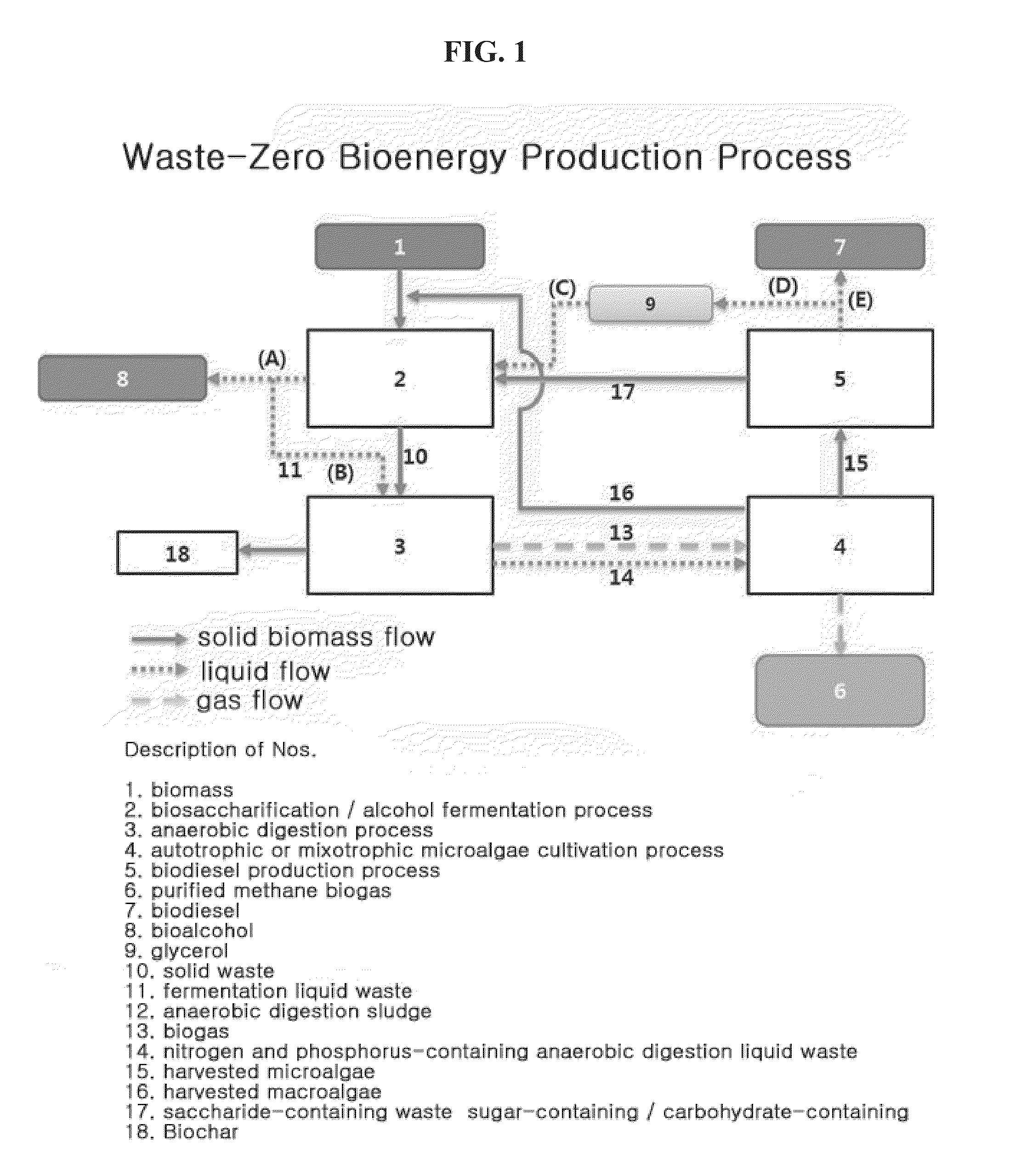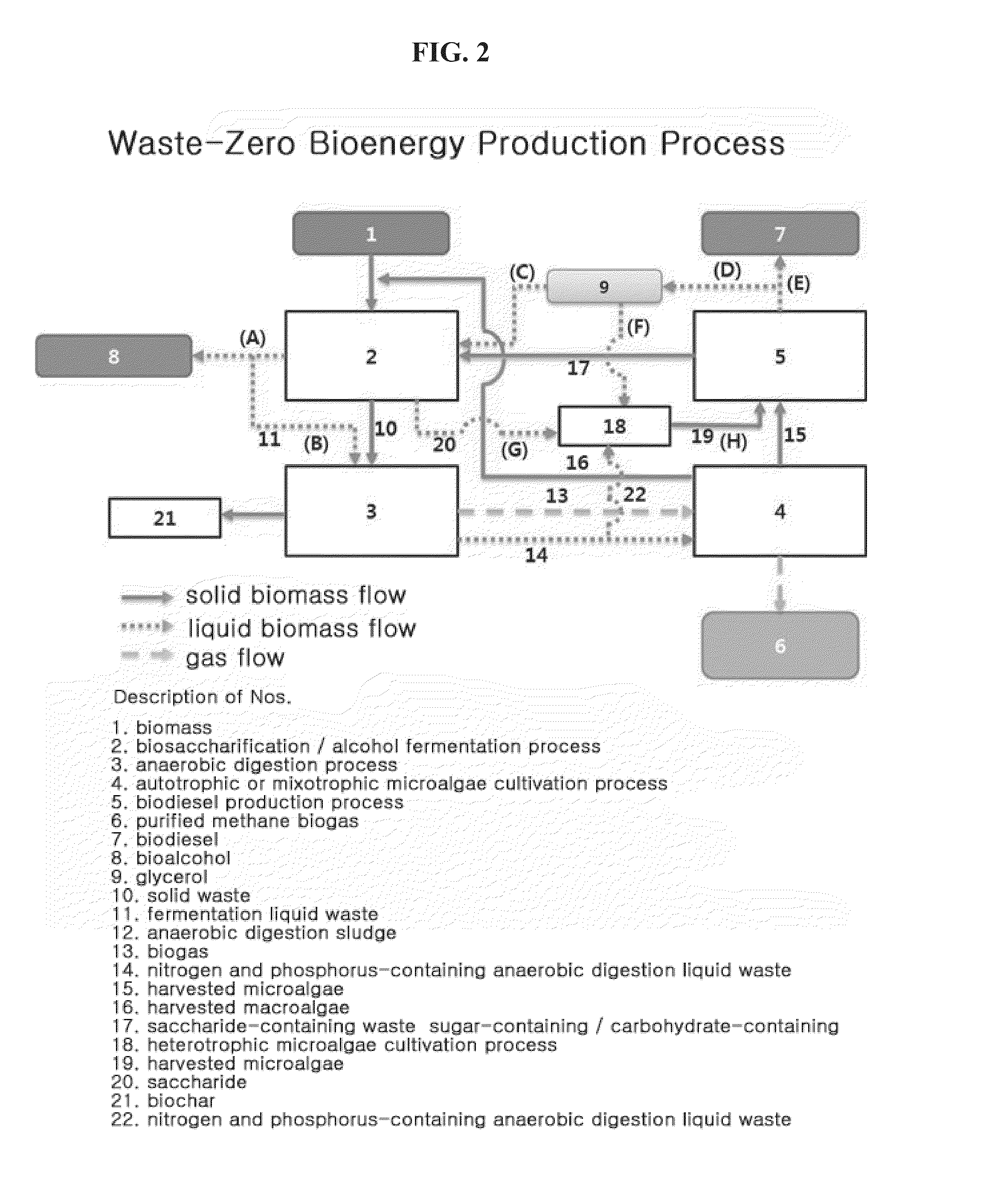Process of producing bioenergy with low carbon dioxide emissions and zero-waste of biomass
- Summary
- Abstract
- Description
- Claims
- Application Information
AI Technical Summary
Benefits of technology
Problems solved by technology
Method used
Image
Examples
example 1
Experiment on a Zero-Waste Bioenergy Production Process for Calculation of Bioenergy Productivity of the Present Invention
[0054]A process simulation regarding the amount of bioenergy production according to its type using fruit byproducts as a raw material was performed by applying the zero-waste bioenergy production process of the present invention based on the mass balance equation. In this Example, fruit byproducts in the amount of 9,000 tons collected over the course of one calendar year were used. The stoichiometric coefficients applied were: a fruit byproducts' carbohydrate content of 80%; a carbohydrate content of the biomass waste, generated in the biodiesel production process, of 30%; a bioethanol yield per carbohydrate of 0.45; a bioethanol yield per glycerol waste of 0.45; a butanol production rate, relative to that of ethanol, of 5%; a biogas yield per unit of biomass in the anaerobic digestion process of 0.3; concentrations of carbon dioxide and methane in the biogas of...
example 2
Removal of Carbon Dioxide and Hydrogen Sulfide from Microalgae Cultivator
[0057]Microalgae Scenedesmus accuminatus AG10316 was cultivated in an Fe(III) EDTA-containing photobioreactor with a supply of 5% CO2 and 0.01% H2S. Fe(III) EDTA was used as an absorbent for H2S oxidation. For the control group, all cultivation conditions were the same except for the presence of microalgae in place of the macroalgae of Example 1. The experimental results revealed that H2S was precipitated as free sulfur (S°), and CO2, being microalgae's carbon source, was fixed in the form of biomass via photosynthesis. The experimental results also revealed: the rate of CO2 removal according to the concentration of added Fe(III) EDTA (FIG. 3A), the rate of H2S removal (FIG. 3B), the change in optical density according to cell concentration (FIG. 3C), and the change in Fe(III) concentration according to cell concentration (FIG. 3D).
[0058]In this Example, the Fe(III) EDTA concentration being added in the range o...
example 3
Production of Bioalcohol from Glycerol
[0059]The ethanol-producing yeast strain, Saccharomyces cerevisiae KCTC 7296, was purchased from the Biological Resource Center (BRC) of Korea Research Institute of Bioscience and Biotechnology (KRIBB). The yeast strain was cultured in a GPY medium (see Table 2) kept at 30° C. aerobically at a rate of 130 rpm, and then stored along with 25% glycerol in a deep freeze at −72° C., and used as a testing material of the present invention.
TABLE 2Composition of GPY medium for S. cerevisiae KCTC 7296Componentg / LGlucose40Peptone5Yeast extract5
[0060]The composition of the ethanol-producing medium for S. cerevisiae KCTC 7296 contained 150 g of glucose, 1.95 g of NH4Cl, 0.12 g of MgSO47H2O, 0.06 g of CaCl2, and 8.5 g of yeast extract. For culturing the S. cerevisiae KCTC 7296 frozen in 25% glycerol as a test material, it was inoculated onto the GPY agar medium, incubated at 30° C. for 23 days, activated, and then single colonies were inoculated onto 100 mL ...
PUM
| Property | Measurement | Unit |
|---|---|---|
| Fraction | aaaaa | aaaaa |
| Fraction | aaaaa | aaaaa |
| Molar density | aaaaa | aaaaa |
Abstract
Description
Claims
Application Information
 Login to View More
Login to View More - R&D
- Intellectual Property
- Life Sciences
- Materials
- Tech Scout
- Unparalleled Data Quality
- Higher Quality Content
- 60% Fewer Hallucinations
Browse by: Latest US Patents, China's latest patents, Technical Efficacy Thesaurus, Application Domain, Technology Topic, Popular Technical Reports.
© 2025 PatSnap. All rights reserved.Legal|Privacy policy|Modern Slavery Act Transparency Statement|Sitemap|About US| Contact US: help@patsnap.com



